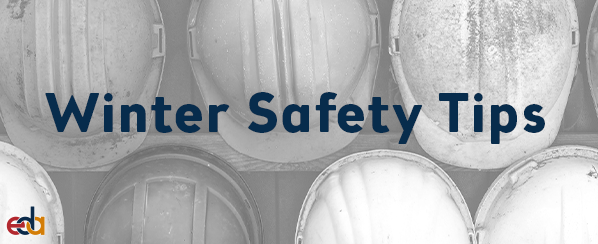Winter weather adds several new hazards to an already dangerous profession. Unpredictable weather is no stranger to the construction industry, but cold and snow can lead to increased risk for slips, frozen fingers, damaged equipment, and more. These added risks do not take away from the daily safety concerns that already come from operating heavy machinery, working at heights, and the mental strain of dealing with regularly changing work conditions. This means that it is important for workers to stay in-tune with safety guidelines and act with a heightened awareness of these practices as the weather gets colder. To help you stay safe this winter, we have compiled seven important safety tips that you should follow when working in cold weather.
Monitor Weather Forecasts
It is important for workers to keep an eye on weather forecasts, as conditions can change quickly. Unfit conditions like blizzards and hailstorms can make jobsites dangerous and commutes impossible. If you know that inclement weather is coming, make sure to give workers adequate time to clean up and secure their jobsite so that they can get home before a storm arrives. If weather forecasts remain adequate for working, be mindful for signs of hypothermia, wear appropriate clothing, and take breaks when needed.
Stay Hydrated
The importance of staying hydrated, especially in the winter months is often neglected. You cannot rely on thirst alone to remind you to drink water, and it is safe to assume that if you are completing physical labor, you are losing fluids. Staying hydrated helps to keep you alert, maintain a safe blood pressure, and helps ensure that your body can generate enough heat to maintain its internal temperature. If you find it difficult to drink water in cold weather, things like decaffeinated hot tea, herbal teas, and ciders are great alternatives that help keep you hydrated. It is important to remember that alcohol and caffeine are not good alternatives to water because they cause further dehydration.
Provide a Heated Area for Breaks
Encouraging workers to take frequent breaks and ensuring some type of heated trailer, tent, or indoor area will help workers stay warm and conserve energy. This is also a good time to monitor workers for signs of frostbite or hypothermia. When having a heated structure is not possible, making hot drinks accessible and limiting continuous time on jobsites are good ways to reduce your workers’ risks to the elements. When you do have an enclosed space, you must remember to maintain appropriate standards when it comes to using propane and heaters. Do not forget to protect heaters from tipping, keep them away from combustible materials, and never smoke near a gas heating source.
Wear Proper PPE
Continuing to wear proper PPE in the winter is important, but winter-specific PPE can often be bulky and cause new hazards to workers. Things like blocked vision or loss of peripheral vision, limited hearing, eyewear fogging, and lack of mobility, can all create hazards that are not present in warmer weather. Balancing protection against the weather and your job tasks can be difficult, but it is a vital part of keeping your body protected in colder months. Taking some extra time to research and weigh what you need to complete a job safely is an important way to keep you warm and safe.
Ensure Equipment is Ready for Cold
Running equipment cold can cause damage to its mechanicals. Ensuring your equipment is ready for the winter months should always be completed in preparation for the cold. Preparing equipment can include things like ensuring fluids are rated for low temperatures and checking heaters in cabs before the weather gets cold. Once cold weather arrives, clearing off ice and snow and protecting your equipment that is regularly exposed to the elements will help ensure they last longer. Oftentimes giving your machines enough time to heat up on their own and reach the correct operating temperature will keep it working efficiently, without bringing on costly repairs.
Remove Snow and Ice
Ensuring snow and ice is removed and salt is applied to slippery surfaces should be completed before work starts. Additionally, it is important to avoid scheduling work on rooftops and scaffolding after snowfall whenever possible. Ladders and elevated surfaces are often forgotten but need to be treated as a slippery surface. If for any reason there is a location where you cannot remove ice, you should mark it and prevent access. It is important to understand that snow removal comes with added risk for injury, so be sure to practice proper lifting techniques if snow removal is your responsibility. It is always smart to check with a supervisor if you are unsure of who is supposed to remove snow from a jobsite. Lastly, if you are driving heavy equipment, remember to go slow, as 24% of all weather-related road accidents are caused by ice. You should always expect wet surfaces to be slippery and be mindful of the risk of losing control of your vehicle.
Educate Workers on Frostbite and Hypothermia
It is important to make education on the symptoms of frostbite and hypothermia part of your safety trainings. Things like shivering, clumsiness, and slurred speech are all signs of hypothermia and should trigger an emergency response as soon as they are identified. By having a basic understanding of the signs and symptoms, workers can receive immediate medical attention, which improves long-term risks. If you are concerned that somebody is exhibiting signs of frostbite or hypothermia, get help immediately.
Winter Safety Resources
In addition to the tips listed, we recommend keeping these resources available as a reminder of ways to keep safe in winter:
OSHA Snow Removal: Know the Hazards
